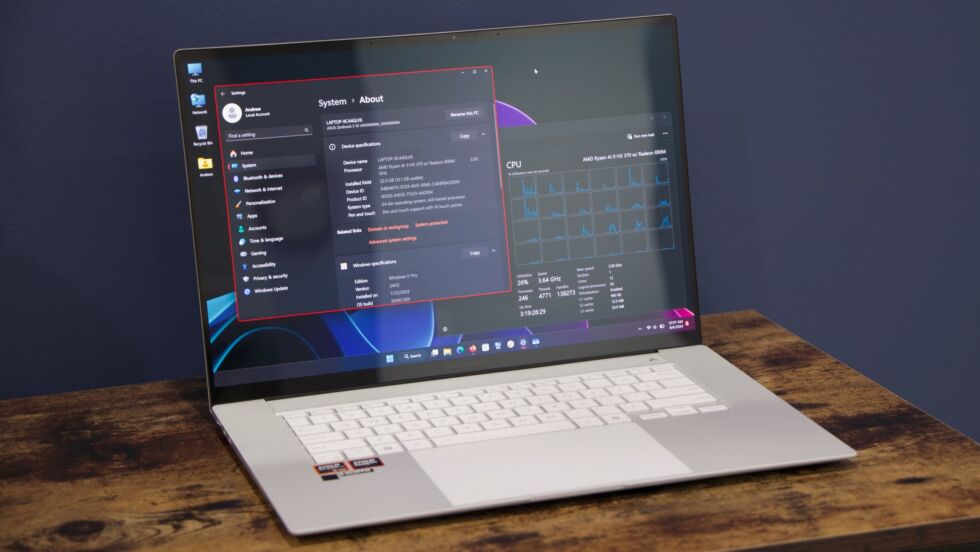
Andrew Cunningham
For all the noise about neural processing units (NPUs) and the generative AI capabilities of new and upcoming chips, NPUs don’t yet do all that much in terms of day-to-day, bread-and-butter computing.
So when I’m evaluating new processors that make a big deal about their AI processing capabilities, my unofficial rule of thumb has been to mostly ignore the AI stuff and focus on more traditional metrics: If the AI bubble popped tomorrow and the hype wave dissipated, would these still be worthwhile chips? Qualcomm’s Snapdragon X SoCs were launched alongside a pile of AI-related software announcements, but they’re impressive mostly because they’re very good at basic computer-y things: They feel fast, and they enable good battery life.
Despite the “AI” that AMD has added to the name, I’m looking at the new Ryzen AI 300-series pretty much the same way. The test system AMD provided—a 16-inch Asus ZenBook UM5606W with a Ryzen AI 9 HX 370 and an integrated Radeon 890M GPU in it—shows that the chip is a small but significant bump over the older Ryzen 7000- and 8000-series laptop CPUs. For various reasons, those chips were already a bit easier to recommend than Intel’s 13th-generation Core processors and both Ultra and non-Ultra Intel Core CPUs, and the Ryzen AI upgrade provides solid boosts to CPU performance and graphics while still maintaining good power efficiency and battery life.
This Asus ZenBook, and a brief note on AI stuff
This isn’t an in-depth review of the ZenBook UM5606W, but here’s a high-level overview if you’re curious.
I’d place this in the same “large thin-and-light” category as the Surface Laptop 15 and the 15-inch MacBook Air, a laptop that acknowledges that people sometimes want larger screens without also needing expensive power-draining dedicated GPUs or toasty desktop-class CPUs. And it’s a broadly inoffensive laptop, with no deal-breaking problems I encountered in a week or so of use.
Its worst sin is its white keyboard with a white keyboard backlight, something that has never been a great idea because it always makes the key legends harder rather than easier to read in medium to bright indoor or outdoor light. Unless the room you’re in is actually dark or nearly dark, turning it off almost always makes the keyboard nicer to look at. The glassy screen is also tremendously reflective, which doesn’t bother me much but which could be a problem if you’re frequently working outdoors.
The laptop has a decent port selection—two 40Gbps USB-C ports, a full-size HDMI port, a USB-A port, a full-size SD card slot, and a headphone jack. The OLED screen looks great and covers 100 percent of the sRGB and DCI-P3 color gamuts. Both the keyboard and trackpad work well enough that I don’t have notes, aside from the backlight thing. And obviously, since this is using a good-old x86 chip, you won’t deal with any of the lingering compatibility issues that are still part and parcel of a Snapdragon-based system.

Andrew Cunningham
Of course, even the Copilot+ stuff that does exist isn’t actually working on x86 PCs just yet, even though the ZenBook does ship with a version of Windows 11 24H2 installed rather than 23H2. In theory, this update is still technically a beta for most x86 PCs, though Microsoft and the PC makers are shipping and supporting it on Arm-powered Copilot+ PCs.
To ensure that it can still talk about AI stuff despite a lack of AI-driven Windows features, AMD is promoting a beta of TensorStack’s Amuse 2.0 image-generation software that runs entirely locally. The hardware recommendations are pretty steep; you need a Ryzen AI 300 system with 24GB of RAM, a computer with a Radeon 7000-series GPU, or a Ryzen 8040-series chip with 32GB of RAM (Ryzen 7000 laptop CPUs and Ryzen 8000G desktop CPUs, all chips with NPUs that were promoted heavily as being AI-capable, are not mentioned).
But those recommendations are only really requirements if you want “XDNA Super Resolution” upscaling. The funny thing about the Amuse software is that it doesn’t even touch the Ryzen AI chip’s much-talked-about NPU—it’s rendering everything on the Radeon 890M GPU, just like it uses the Radeon GPU on the desktop. And since it’s really just using the GPU, Amuse will download, install, and run on just about anything, making it less than convincing both as a selling point for Ryzen AI processors and as a showcase for chips with fancy NPUs in them.
